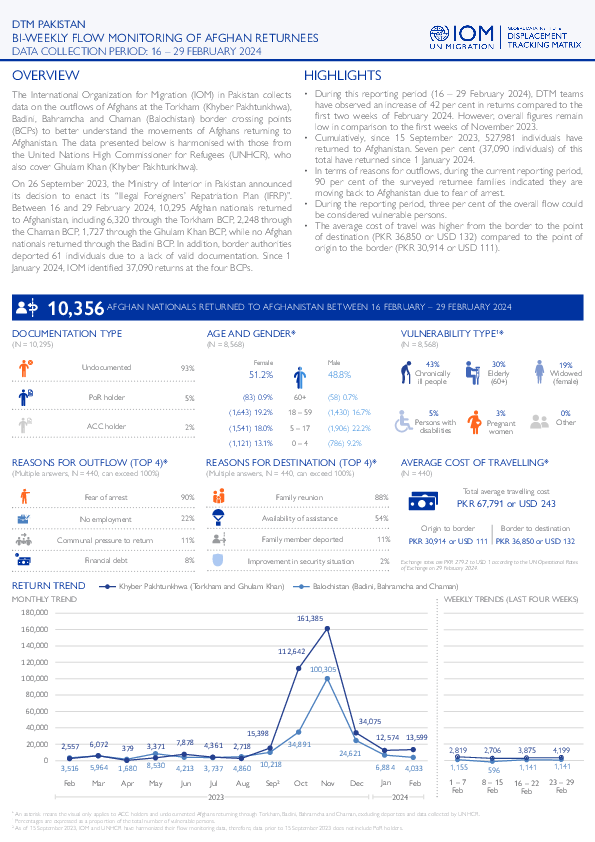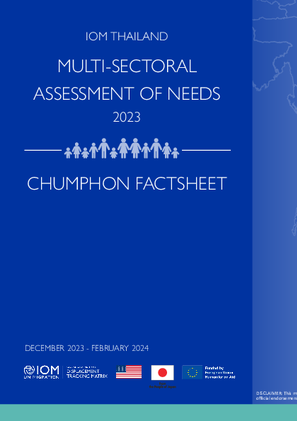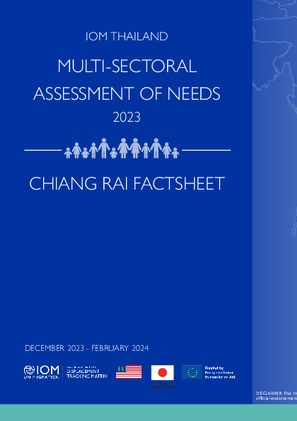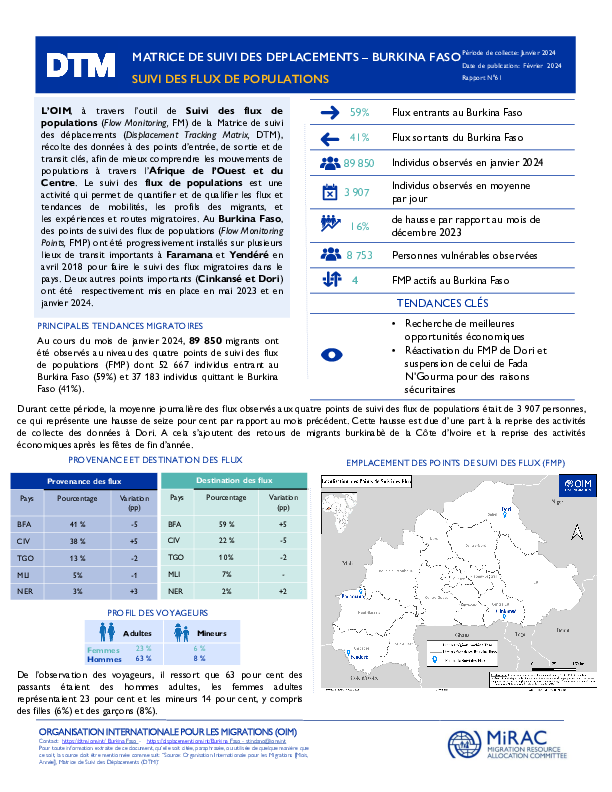-
Countries
-
Data and Analysis
-
Special Focus
-
Crisis Responses
Flow Monitoring
Domain host
migration.iom.int

Contact
DTMAfghanistan@iom.int
Language
English
Location
Afghanistan
Period Covered
Feb 25 2024
Mar 02 2024
Activity
- Survey
- Flow Monitoring Survey
- Flow Monitoring
IOM Afghanistan's DTM Flow Monitoring activity, initiated at the beginning of 2024, seeks to quantify and better understand the mobility dynamics at Afghanistan’s borders. On 10 January 2024, DTM began deploying field teams at four border crossing points with the Islamic Republic of Iran (IRN) and Pakistan (PAK), expanding to another border crossing point Ghulam Khan as of 11 February (see map below for the locations of all five crossing points), to conduct two interlinked exercises. The first is a headcount of all individuals entering or leaving Afghanistan (including returnees), also called Flow Monitoring Counting (FMC), to gauge flow volume. The second is a survey of randomly selected Afghan national individuals or groups entering or leaving Afghanistan, also called the Flow Monitoring Survey (FMS), to understand the profiles, motivations, and vulnerabilities of the target population. This snapshot provides key findings combining various IOM data sources, including DTM Afghanistan’s FMC and FMS activities, DTM Pakistan’s Flow Monitoring of Afghan returnees, and IOM Afghanistan’s Cross-Border Post-Arrival Humanitarian Assistance (CB-PAHA) program, for the period 25 February to 2 March 2024. For more information about methodology, see the section in the last page of this report titled “IOM INFLOW DATA.”

Contact
DTM Pakistan, iomisbdtmremapteam@iom.int
Language
English
Location
Pakistan
Period Covered
Feb 16 2024
Feb 29 2024
Activity
- Flow Monitoring
On 26 September 2023, the Ministry of Interior in Pakistan announced its decision to enact its “Illegal Foreigners’ Repatriation Plan (IFRP)”. Between 16 and 29 February 2024, 10,295 Afghan nationals returned to Afghanistan, including 6,320 through the Torkham BCP, 2,248 through the Chaman BCP, 1,727 through the Ghulam Khan BCP, while no Afghan nationals returned through the Badini BCP. In addition, border authorities deported 61 individuals due to a lack of valid documentation. Since 1 January 2024, IOM identified 37,090 returns at the four BCPs.

Contact
DTM Somalia, IOMSomaliaDTM@iom.int
Language
English
Location
Somalia
Period Covered
Dec 01 2023
Dec 31 2023
Activity
- Flow Monitoring
A total of 19,192 movements were observed in December 2023, representing a 16% increase compared to November 2023 when 16,614 movements were observed during this period. If compared with November 2023, Doolow (44%), Harirad (30%), Dhobley (17%) and Bossaso (6%) FMPs recorded an increase in movements while Lowyacado (-28%), Buuhoodle (-20%) and Cabudwaaq (-7%) FMP recorded a decrease in movements. Doolow (29%), Dhobley (21%) and Cabudwaaq (20%) FMPs recorded the highest numbers of incoming flows, while Doolow (47%), Bossaso (35%) and Dhobley (7%) recorded the highest numbers of outgoing flows.

Contact
DTMThailand@iom.int
Language
English
Location
Thailand
Period Covered
Dec 14 2023
Feb 12 2024
Activity
- Survey
- Site Assessment
This factsheet aims to provide a snapshot of multi-sectoral conditions, needs, and challenges among Myanmar migrants in Chumphon province as captured between December 2023 and February 2024 by IOM Thailand’s multi-sectoral assessment of needs. The purpose of this assessment is to provide insights regarding the severity of needs among migrant populations, identify vulnerable population groups and geographic areas with the most acute needs, inform assistance planning and relevant Sustainable Development Goals (SDGs) targets, and provide sectoral and inter-sectoral baselines for future assessments.

Contact
DTMThailand@iom.int
Language
English
Location
Thailand
Period Covered
Dec 20 2023
Feb 05 2024
Activity
- Survey
- Site Assessment
This factsheet aims to provide a snapshot of multi-sectoral conditions, needs, and challenges among Myanmar migrants in Chiang Rai province as captured between December 2023 and February 2024 by IOM Thailand’s multi-sectoral assessment of needs. The purpose of this assessment is to provide insights regarding the severity of needs among migrant populations, identify vulnerable population groups and geographic areas with the most acute needs, inform assistance planning and relevant Sustainable Development Goals (SDGs) targets, and provide sectoral and inter-sectoral baselines for future assessments.

Contact
DTM Burkina Faso, BFInformationUnit@iom.int
Language
French
Location
Burkina Faso
Period Covered
Jan 01 2024
Jan 31 2024
Activity
- Flow Monitoring
L’OIM, à travers l’outil de Suivi des flux de populations (Flow Monitoring, FM) de la Matrice de suivi des déplacements (Displacement Tracking Matrix, DTM), récolte des données à des points d’entrée, de sortie et de transit clés, afin de mieux comprendre les mouvements de populations à travers l’Afrique de l’Ouest et du Centre. Le suivi des flux de populations est une activité qui permet de quantifier et de qualifier les flux et tendances de mobilités, les profils des migrants, et les expériences et routes migratoires. Au Burkina Faso, des points de suivi des flux de populations (Flow Monitoring Points, FMP) ont été progressivement installés sur plusieurs lieux de transit importants à Faramana et Yendéré en avril 2018 pour faire le suivi des flux migratoires dans le pays. Deux autres points importants (Cinkansé et Dori) ont été respectivement mis en place en mai 2023 et en janvier 2024.

Contact
ROPretoriaRMDHub@iom.int
Language
English
Location
Malawi
Period Covered
Jan 01 2024
Jan 31 2024
Activity
- Flow Monitoring
This report is an overview of the data collected from 1 to 31 January 2024 at Mangochi FMP in Malawi along the border with Mozambique and Karonga FMP in Malawi along the border with the United Republic of Tanzania. The Flow Monitoring Registry (FMR) collects data at Flow Monitoring Points (FMPs) through direct observation and interviews with key informants, including staff working at transit stations, border patrol officers, local authorities, bus or taxi drivers and travellers themselves. The FMR gathers data on the number of travellers crossing FMPs, as well as the provenance, next destination, vulnerabilities and means of transport of travellers.

Contact
DTMAfghanistan@iom.int
Language
English
Location
Afghanistan
Period Covered
Feb 18 2024
Feb 24 2024
Activity
- Survey
- Flow Monitoring Survey
- Flow Monitoring
IOM Afghanistan's DTM Flow Monitoring activity, initiated at the beginning of 2024, seeks to quantify and better understand the mobility dynamics at Afghanistan’s borders. On 10 January 2024, DTM began deploying field teams at four border crossing points with the Islamic Republic of Iran (IRN) and Pakistan (PAK), expanding to another border crossing point Ghulam Khan as of 11 February (see map below for the locations of all five crossing points), to conduct two interlinked exercises. The first is a headcount of all individuals entering or leaving Afghanistan (including returnees), also called Flow Monitoring Counting (FMC), to gauge flow volume. The second is a survey of randomly selected Afghan national individuals or groups entering or leaving Afghanistan, also called the Flow Monitoring Survey (FMS), to understand the profiles, motivations, and vulnerabilities of the target population. This snapshot provides key findings combining various IOM data sources, including DTM Afghanistan’s FMC and FMS activities, DTM Pakistan’s Flow Monitoring of Afghan returnees, and IOM Afghanistan’s Cross-Border Post-Arrival Humanitarian Assistance (CB-PAHA) program, for the period 18 to 24 February 2024. For more information about methodology, see the section in the last page of this report titled “IOM INFLOW DATA.”
Within the West and Central Africa (WCA) region, the Sahel stretches from Mauritania to Chad, separating the Sahara desert on the North, from tropical coastal countries to the South. Overall, within the African continent, it spans from the Atlantic Ocean on the West to the Red Sea on the East, separating the desert from the savanna. Migratory routes within the WCA region inevitably cross the Sahel and - throughout their journeys - migrants are facing multiple risks along these routes.
This report compiles information from different data and research activities held within the region in the objective to highlight the diverse dynamics, profiles and risks migrants are facing while travelling on the WCA routes through the Sahel. This dashboard covers the period until December 2023 and is based on information from (1) Displacement Tracking Matrix (DTM) data on mobility trends and population flows; (2) Missing Migrants Project (MMP) data on arrivals to Europe and the Canary Islands, migrant deaths and disappearances; (3) Data on migrants seeking Assisted Voluntary Return and Reintegration (AVRR) to and within the WCA region; (4) Expulsions of migrants from other regions to WCA, especially from Algeria and Libya; (5) Transhumance Tracking Tool (TTT) data on the mobility of transhumant populations throughout the Sahel; and (6) Solutions and Mobility Index (SMI) indicators of stability within the Sahelian region.

Contact
DTM Pakistan, DTMPakistan@iom.int
Language
English
Location
Pakistan
Period Covered
Feb 01 2024
Feb 15 2024
Activity
- Flow Monitoring
On 26 September 2023, the Ministry of Interior in Pakistan announced its decision to enact its “Illegal Foreigners’ Repatriation Plan (IFRP)”. Between 1 and 15 February 2024, 7,215 Afghan nationals returned to Afghanistan, including 5,040 through the Torkham BCP, 1,720 through the Chaman BCP, 455 through the Ghulam Khan BCP, while no Afghan nationals returned through the Badini BCP. In addition, border authorities deported 61 individuals due to a lack of valid documentation. Since 1 January 2024, IOM identified 26,734 returns at the four BCPs.
Pagination
- Previous page
- Page 23
- Next page
